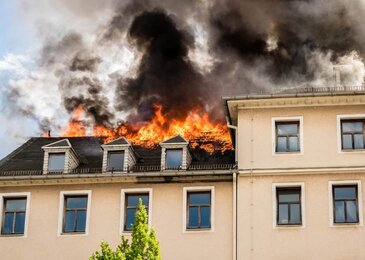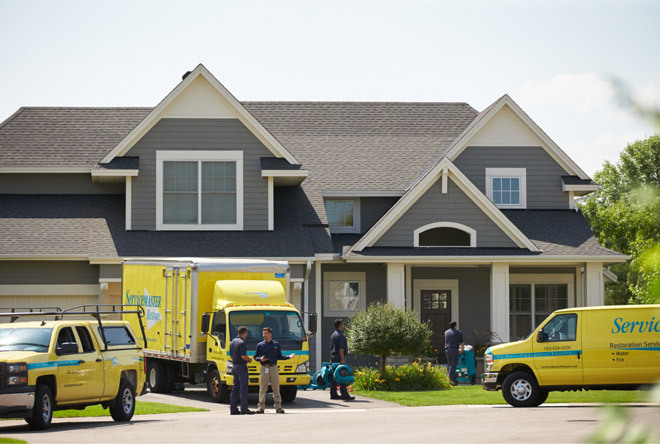Disaster Recovery Tips & Advice

Learn what to do and what not to do for water, fire, and smoke damage.
If you're in the midst of a water, fire or smoke disaster, know that ServiceMaster at Bakersfield will be there when you call us. Be sure to protect yourself! Cleaning up a structure fire is dangerous as walls could collapse, batteries could explode, and there may be chemicals present that are harmful to your health. In the meantime, here are some ways to mitigate the damage yourself.
What to do if you ever have water damage:
- At a minimum, wear an N-95 respirator mask, goggles and protective gloves.
- If the outside temperature is above 60 degrees, use dehumidifiers if available.
- Use fans to circulate the air and assist drying.
- Remove as much standing water as possible by mopping and blotting.
- Wipe furniture dry.
- Lift draperies off carpet, loop through a coat hanger, and place the hanger on the drapery rod.
- Prop up wet furniture cushions for even drying and place small wood blocks or aluminum foil under furniture legs.
- Remove wet area rugs or other floor coverings.
- Open furniture drawers, closet doors, and luggage to enhance drying.
- Move photos, paintings, and art objects to a safe, dry location.
- Remove wet fabrics and dry them as soon as possible. Hang furs and leather goods to dry separately at room temperature.
- Remove damp books from shelves and spread out to dry.
- If damage occurs during a cool season, leave heat on; if in summer, use an air conditioner if available.
- If using a portable generator for power keep it outside and as far away as possible to prevent carbon monoxide build up.
Important warnings on water damage
- Do not use an ordinary household vacuum to remove water.
- Do not use electrical appliances while on wet carpet or wet floors.
- Do not go into rooms with standing water if the electricity is still on.
- Do not lift tacked down carpet without professional help. Lifting the carpet incorrectly could promote shrinkage.
- Do not wait to call for professional help. Damage from the water and bacteria growth can begin within hours.
What to do if you have smoke/fire damage:
- At a minimum, wear an N-95 respirator mask, goggles and protective gloves.
- Blow off or brush-vacuum loose soot particles from upholstery, drapes, and carpets.
- Cover carpeted traffic areas with towels or old linens to prevent additional soiling.
- Discard open food packages. The food could be contaminated.
- If electrical service is off, clean out your freezer and refrigerator. Leave the doors propped open or place charcoal in the unit.
- Send clothing with heavy smoke damage to a qualified professional dry cleaner who specializes in smoke damage.
- Clean Formica and chrome fixtures in the kitchen and bathroom to prevent permanent tarnishing.
- Wipe residue from porcelain bath fixtures to prevent etching.
- Wipe the leaves of houseplants to remove smoke residue.
- Change the air filter on your furnace if it uses forced hot air.
- Tape cheesecloth over intake and outlet air registers to capture any loose soot in the air. This is even more effective if the cheesecloth is damp.
- If the outside temperature is above 60 degrees, air out the house to reduce smoke odor.
Important warnings on smoke and fire damage
- Do not attempt to wash any papered or flat painted walls without consulting your professional cleaner. Incorrect cleaning procedures could compound the soot residue problem.
- Do not attempt to clean carpets or upholstered furniture. Again, incorrect procedures could increase damage.
- Do not use electrical appliances that have been close to fire or water before having them checked. They could malfunction.
- Do not use ceiling fixtures if the ceiling is wet. A short circuit could result.
- Do not touch anything. Soot on your hands can permeate upholstery, walls, and woodwork, causing further damage.
- Do not eat food that has been exposed to fire or smoke.
- Do not wait to call for professional help.
EPA's Renovation, Repair and Painting Rule (RRP)
As of April 22, 2010 renovation, repair and painting contractors must:
- Be "RRP Certified"
- Use lead safe work practices when working in homes built before 1978
The RRP rule affects contractors, property managers and others who disturb known or presumed lead-based paint during renovation activities done for compensation. This includes most repair, remodeling and maintenance jobs, such as but not limited to, window replacement, weatherization and demolition. The rule applies to any work that disturbs painted surfaces in residential houses, apartments and child-occupied facilities such as schools and day-care centers built before 1978.
Download the EPA Right to Renovate consumer brochure.
Fines for violating the RRP Rule requirements can be up to $37,500 per incident per day!! Learn more about the rule at http://www.epa.gov/lead/rrp-reg.html
Health Precautions & Concerns
Bacteria & Mold Hazards Associated with Water Damage
Water damaged building interiors provide a "prime" environment
for the growth and reproduction of bacteria and mold. Both are parasitic,
i.e., they rely on dead or decaying organic matter for food. Favorite
foods for bacteria and mold are cellulose based building material, such
as wood, drywall and any soiled surface. Synthetic carpet fibers do not
support microbial growth but the soils attached to them certainly do.
These factors, coupled with warm humid air, create the ideal environment
for reproduction. Bacteria and mold may cause allergic reactions, arthritis,
puffy eyes, chronic cough, rheumatism, asthma, depression and headache.
Water damage restoration must be performed by trained technicians who understand
proper procedures and applications. Trained personnel will provide the
necessary adjustments to the environment by altering temperature and humidity
levels to deter production of bacteria and mold and setting up professional
drying equipment to facilitate complete structural drying.
Breathing & Electrical Hazards Associated with Fire Damage
Structures that have been affected by fire may have strong, potentially
toxic, odors. Never enter a smoking or smoldering area without the proper
breathing equipment. Fires can also compromise electrical systems presenting
serious electrical hazards. Do not attempt to unplug burned appliances
or equipment unless you are certain that the power to the building has
been shut-off. Failure to do so could result in electrical shock.
Residual water from fire fighting will add to the damage as mentioned above,
creating health concerns. There may be fallen debris containing sharp
surfaces, in addition to slip or trip hazards. Emergency services may
be necessary to stabilize the structure, make it safe for occupancy and
restoration, and mitigate against further damage.
Asbestos
Federal, state and local regulations require owners and operators of non-residential buildings and structures to conduct asbestos surveys. You can rely on ServiceMaster at Bakersfield to comply with federal, state and local EPA and OSHA regulations while performing work. For more information on regulations in your area, log on to:


